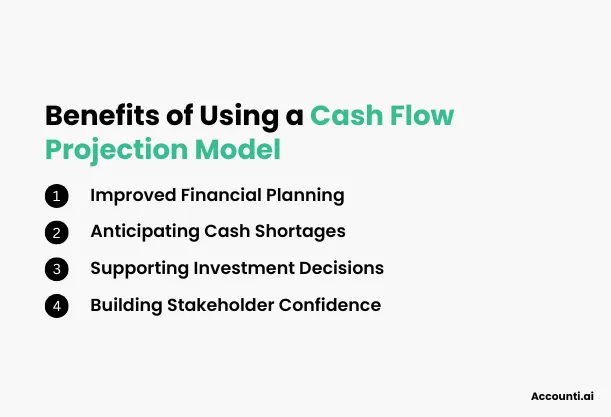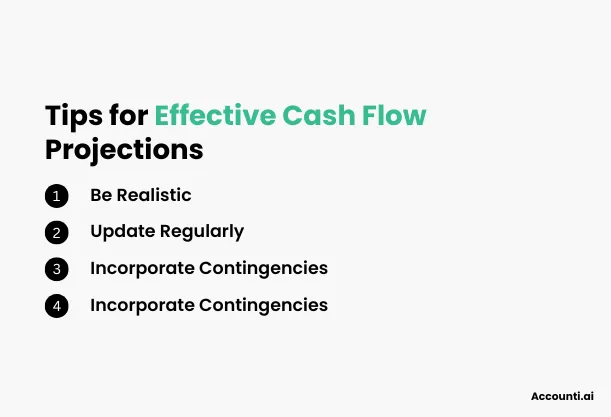
Creating A Cash Flow Projection Model: Template And Benefits
Every successful business needs to keep a close eye on its finances. While profit and loss statements tell you whether you’re making money, cash flow tells the true story of your business’s health. That’s where a cash flow projection model comes into play. This tool helps you predict, manage, and plan your cash inflows and outflows so you can avoid surprises and make informed decisions.
In this guide, we’ll dive into what a cash flow projection model is, the benefits of using one, and how to create a template that works for your business. Stick around for some tips, a sample template, and answers to common questions.
What is a Cash Flow Projection Model?
A cash flow projection model is a financial tool that forecasts the movement of cash in and out of your business over a specific period. It serves as a roadmap for managing your liquidity and ensuring you always have enough cash on hand to meet your obligations.
Think of it as a crystal ball for your finances—it doesn’t just show you where you stand today but helps predict what’s around the corner.
Key Components of a Cash Flow Projection
To create a projection model, you need to focus on these key elements:
- Cash Inflows: Money coming into your business (e.g., sales revenue, loans, investments).
- Cash Outflows: Money leaving your business (e.g., operating expenses, salaries, loan repayments).
- Net Cash Flow: The difference between inflows and outflows.
- Time Frame: Periods like weekly, monthly, or quarterly to track cash flow trends.
Benefits of Using a Cash Flow Projection Model
Why bother with cash flow projections? Because they’re more than just numbers—they’re a tool to help you make smarter decisions. Here’s how:

1. Improved Financial Planning
A cash flow projection allows you to identify periods where cash might be tight or abundant. This helps in planning for expenses like payroll, rent, and inventory purchases without running out of funds.
2. Anticipating Cash Shortages
Ever been caught off guard by a big bill? A good projection model ensures you’re prepared for such scenarios by identifying gaps in advance.
3. Supporting Investment Decisions
Thinking of buying new equipment or expanding your team? Projections help you determine if you’ll have enough cash to support those investments.
4. Building Stakeholder Confidence
Whether it’s investors or lenders, showing that you have a firm grasp on your cash flow builds trust and credibility. It signals that you’re running a stable operation.
How to Create a Cash Flow Projection Model
Creating a cash flow projection might sound intimidating, but breaking it into manageable steps makes the process seamless. Here’s how to do it:
Step 1: Collect Relevant Data
Before you start, gather all the necessary information. This includes:
- Historical Cash Flow Data: Analyze past financial performance to establish trends.
- Projected Income: Estimate upcoming revenue based on sales forecasts, contracts, or seasonal trends.
- Projected Expenses: List fixed costs (e.g., rent) and variable costs (e.g., inventory).
Step 2: Structure the Template
Design your cash flow model with these sections:
- Header: Include the timeframe (e.g., January 2024) and the business name.
- Columns for Periods: Break down cash flow by weeks or months.
- Rows for Inflows/Outflows: List categories like sales, utilities, payroll, etc.
- Net Cash Flow: Include a formula to calculate inflows minus outflows.
Step 3: Populate the Template
Now, input your data:
- Cash Inflows: Add expected revenue from sales, loans, or investments.
- Cash Outflows: Include expenses like wages, taxes, and vendor payments.
- Time Periods: Align these figures with your chosen timeframe.
Step 4: Analyze and Adjust
Once the data is in, look for trends. Are there months where you’re running low on cash? Adjust your plans, such as delaying non-essential expenses or increasing marketing efforts during slow periods.
Cash Flow Projection Template
Here’s a simple table layout for a cash flow projection model. You can expand or tweak this to suit your business’s needs.
|
Category |
Week 1 |
Week 2 |
Week 3 |
Week 4 |
Monthly Total |
|
Cash Inflows |
|||||
|
Sales Revenue |
$2,500 |
$3,000 |
$4,000 |
$3,500 |
$13,000 |
|
Loans |
$1,000 |
- |
- |
- |
$1,000 |
|
Total Inflows |
$3,500 |
$3,000 |
$4,000 |
$3,500 |
$14,000 |
|
Cash Outflows |
|||||
|
Payroll |
$1,200 |
$1,200 |
$1,200 |
$1,200 |
$4,800 |
|
Utilities |
$300 |
- |
$300 |
- |
$600 |
|
Marketing |
$500 |
- |
- |
- |
$500 |
|
Total Outflows |
$2,000 |
$1,200 |
$1,500 |
$1,200 |
$5,900 |
|
Net Cash Flow |
$1,500 |
$1,800 |
$2,500 |
$2,300 |
$8,100 |
You can create this table in a spreadsheet program like Excel or Google Sheets for easy calculations.
Tips for Effective Cash Flow Projections
Want your cash flow model to really work for you? Keep these tips in mind:

1. Be Realistic
It’s tempting to overestimate revenue or underestimate costs. Resist the urge! Realistic projections are far more valuable. Additionally, understanding your burn rate—the rate at which your business spends cash—can further improve the accuracy of your cash flow projections. Learn more about how to calculate burn rate to stay ahead.
2. Update Regularly
Your business isn’t static, and neither should your projections be. Update your model monthly (at a minimum) to reflect the latest financial data.
3. Incorporate Contingencies
Life happens, and unexpected expenses can throw off your projections. Set aside an emergency fund or add a buffer to your outflows.
4. Leverage Technology
Tools like QuickBooks, FreshBooks, or specialized cash flow software can automate calculations and offer insights.
Challenges in Cash Flow Projections and How to Overcome Them
Creating and maintaining a cash flow model isn’t always smooth sailing. Here are some common challenges and solutions:
1. Unpredictable Market Conditions
Markets can change unexpectedly, impacting revenue and costs.
- Solution: Monitor industry trends and adjust your projections accordingly.
2. Difficulty in Forecasting Variable Costs
Variable costs like inventory or shipping can fluctuate widely.
- Solution: Use historical averages and factor in seasonal adjustments.
3. Overlooking Small Expenses
Little costs like office supplies or software subscriptions can add up.
- Solution: Audit your expenses regularly to ensure nothing is missed.
Conclusion
Creating a cash flow projection model might seem like extra work, but it’s an investment in your business’s future. With the right template and approach, you’ll gain better control over your finances, avoid nasty surprises, and make smarter decisions. Start simple, update regularly, and refine as you go.
Remember, a business without a clear cash flow plan is like a ship without a compass—it’s only a matter of time before you’re lost.
FAQs
How to Prepare a Cash Flow Projection?
A cash flow projection estimates the inflow and outflow of cash within your business over a specific period. To prepare one:
- Gather Financial Data: Collect historical data on sales, expenses, and any other cash movements.
- Forecast Sales: Predict future sales based on historical trends, market analysis, and current economic conditions.
- Estimate Expenses: List all expected expenses, including fixed costs (e.g., rent) and variable costs (e.g., utilities).
- Determine Cash Inflows: Include all sources of income, such as sales revenue, loans, and investments.
- Determine Cash Outflows: Account for all expenditures, including operating expenses, salaries, and loan repayments.
- Calculate Net Cash Flow: Subtract total outflows from total inflows to determine net cash flow for each period.
- Review and Adjust: Regularly compare projections with actual figures and adjust as necessary.
This systematic approach helps in anticipating cash shortages and planning for future financial needs.
How to Make a Cash Flow Forecast in Excel?
Creating a cash flow forecast in Excel involves:
- Set Up the Spreadsheet:
- Label columns with time periods (e.g., months).
- Label rows with categories for cash inflows and outflows.
- Input Historical Data: Enter past financial data to establish a baseline.
- Forecast Inflows and Outflows:
- Estimate future cash inflows (e.g., sales, investments).
- Estimate future cash outflows (e.g., expenses, salaries).
- Calculate Net Cash Flow: Use formulas to subtract outflows from inflows for each period.
- Analyze Results: Identify periods of surplus or deficit and plan accordingly.
Excel's flexibility allows for customization to fit your business's specific needs.
How to Create a Cash Flow Model?
A cash flow model projects future cash flows to assess financial health. To create one:
- Define Objectives: Determine the purpose of the model (e.g., budgeting, investment analysis).
- Gather Data: Collect historical financial data and market trends.
- Identify Assumptions: Set assumptions for variables like sales growth, expense increases, and interest rates.
- Build the Model:
- Create a timeline (e.g., monthly, quarterly).
- Project cash inflows and outflows based on assumptions.
- Validate the Model: Compare projections with actual data to ensure accuracy.
- Scenario Analysis: Test different scenarios to understand potential outcomes.
A well-structured cash flow model aids in strategic planning and decision-making.
What is the Formula for Project Cash Flow?
The basic formula for projecting cash flow is:
Net Cash Flow = Total Cash Inflows - Total Cash Outflows
Where:
- Total Cash Inflows: Sum of all cash received (e.g., sales, loans).
- Total Cash Outflows: Sum of all cash spent (e.g., expenses, salaries).
This formula helps determine the net change in cash position over a period.
What Does a Cash Flow Forecast Look Like?
A cash flow forecast typically includes:
- Time Periods: Columns representing time intervals (e.g., weeks, months).
- Cash Inflows: Rows detailing sources of income.
- Cash Outflows: Rows detailing categories of expenses.
- Net Cash Flow: Row showing the difference between inflows and outflows for each period.
- Opening and Closing Balances: Rows indicating cash at the start and end of each period.
This structured format provides a clear view of expected cash movements.
How Do You Estimate Cash Flow for a New Project?
Estimating cash flow for a new project involves:
- Identify Revenue Streams: Determine all potential sources of income.
- Estimate Sales Volume: Predict the quantity of sales based on market research.
- Set Pricing: Establish pricing strategies to forecast revenue.
- Calculate Operating Expenses: List all costs associated with the project, both fixed and variable.
- Determine Capital Expenditures: Account for one-time costs like equipment or setup.
- Project Cash Inflows and Outflows: Map out when income will be received and expenses will be paid.
- Analyze Net Cash Flow: Assess whether the project will generate a positive cash flow over time.
Accurate estimation ensures the project's financial viability and aids in securing funding.

 Rohit Kapoor
Rohit Kapoor

